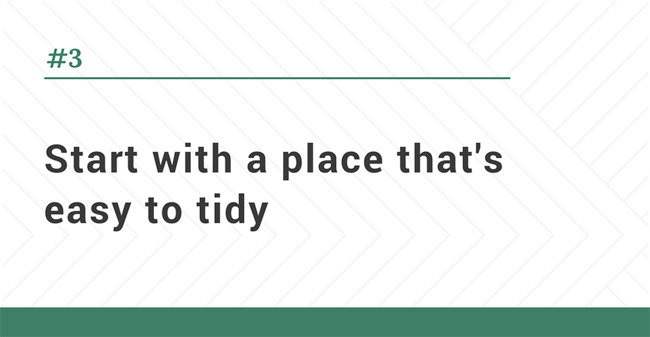The Easiest Decluttering Strategy from the Book That Inspired Marie Kondo
This practical advice from the international bestseller, The Art of Discarding, will change your organizing habits for the better.

Photo: Hero Images/Getty Images
Choose a compact area—a table top, a kitchen shelf, or a washstand, say—and decide you will definitely not put anything there. Then keep your resolution.
Strategy Variations:
1. Decide on a place where you won't put things
2. Decide on a place where you won't store unnecessary things
3. Start with a place that's easy to tidy
Strategy Variations in Practice:

- The kitchen table
- On top of a cabinet
- On top of the fridge
- A washstand
- A desk
- On top of a shoe-storage box
Let's consider the kitchen table. When not in use a table shouldn't really have anything on it. It's a place for eating, not a place for putting things.
But is there any household where the kitchen table doesn’t have anything on it? Newspapers, junk mail, a clock, some medicine, family photographs, a vase of flowers, a bag of sweets, a toy...
Then, when it comes to eating, all these things are just pushed to one side. They're not cleared away.
Try deciding that the kitchen table is a place where you will never put unnecessary things. Even if other places are overflowing, you will not put things on the table. So put the newspaper in the rack; if you want to keep any information from the junk mail or flyers, stick them on the door of the fridge and throw the rest away. Put bags of sweets away in a box. Throw away that medication you’ve stopped taking...
The table top is a relatively small area, so the task is easily done. But it does require a little effort every day, a result of which you'll develop a clear idea of the selection process: putting away what's necessary and disposing of what isn’t. The regular repetition will help discarding become second nature.
You'll also have a nice, clear kitchen table and a sense of achievement.

- Specific drawers
Your handkerchief drawer, your towel drawer, the top drawer in your desk—anywhere will do. Just take a small storage area and decide that you will never put anything unnecessary in there.
And then it's the same as with the kitchen table above. If you find yourself about to throw a meeting file into your stationery drawer, stop. If you're about to put a receipt in the telephone table for safekeeping, don’t. If a CD won’t fit onto its normal shelf, don't just shove it in the drawer.
If you manage to stop yourself dropping things into drawers too easily, you’ll develop the there-and-then habit.

- Towel drawer
- Cosmetics drawer
- Hall closet
It’s difficult to tackle the whole house at once, so start with a compact place used for things that are relatively easy to sort out.
Take the towel drawer, for example. First, think how many towels are necessary. Remove the excess number and decide there and then on how to dispose of them. If the drawer contains giveaway hand towels or sheets and toiletries which shouldn’t be there, take them out and decide what to do with them.
You may find all sorts of things at the bottom of the drawer. As you clear them out, contemplate just how much unnecessary stuff is there.
Once you’ve had your test-run in a compact space, gradually expand your area of operation.
Why This Strategy Works:
It can be tough suddenly to change one’s habits. Discarding isn’t simply about tidiness. It's a whole way of relating to things. If you say to yourself, "Right! I'm going to put this Art-of-Discarding thing into practice now," the chances are that you’ll be overwhelmed by the sheer volume of stuff you're confronted with.
This strategy helps overcome that difficulty. The point is to start with small tasks, rather than taking on a big job all at once.
I recommend that you first try to establish a place where you won't put things (Strategy Variation 1). It's easier to feel the impact if you're dealing with a place you can see. The first thing you’ll notice is how many unnecessary things you have around you, and how they increase in number day by day. As this begins to bother you, you’ll want to do something about it.
By following this strategy you’ll also develop the habit of disposal—of reducing the number of unnecessary things you have. Instead of picking redundant things up and then putting them back, you'll pick them up and dispose of them. This is why it's important to start with a compact place. If the job is too onerous, you’ll get fed up before discarding becomes habit.

Excerpted from The Art of Discarding by Nagisa Tatsumi. Copyright ©2017 by Nagisa Tatsumi. Reprinted by permission of Hachette Books.
Strategy Variations:
1. Decide on a place where you won't put things
2. Decide on a place where you won't store unnecessary things
3. Start with a place that's easy to tidy
Strategy Variations in Practice:

- The kitchen table
- On top of a cabinet
- On top of the fridge
- A washstand
- A desk
- On top of a shoe-storage box
Let's consider the kitchen table. When not in use a table shouldn't really have anything on it. It's a place for eating, not a place for putting things.
But is there any household where the kitchen table doesn’t have anything on it? Newspapers, junk mail, a clock, some medicine, family photographs, a vase of flowers, a bag of sweets, a toy...
Then, when it comes to eating, all these things are just pushed to one side. They're not cleared away.
Try deciding that the kitchen table is a place where you will never put unnecessary things. Even if other places are overflowing, you will not put things on the table. So put the newspaper in the rack; if you want to keep any information from the junk mail or flyers, stick them on the door of the fridge and throw the rest away. Put bags of sweets away in a box. Throw away that medication you’ve stopped taking...
The table top is a relatively small area, so the task is easily done. But it does require a little effort every day, a result of which you'll develop a clear idea of the selection process: putting away what's necessary and disposing of what isn’t. The regular repetition will help discarding become second nature.
You'll also have a nice, clear kitchen table and a sense of achievement.

- Specific drawers
Your handkerchief drawer, your towel drawer, the top drawer in your desk—anywhere will do. Just take a small storage area and decide that you will never put anything unnecessary in there.
And then it's the same as with the kitchen table above. If you find yourself about to throw a meeting file into your stationery drawer, stop. If you're about to put a receipt in the telephone table for safekeeping, don’t. If a CD won’t fit onto its normal shelf, don't just shove it in the drawer.
If you manage to stop yourself dropping things into drawers too easily, you’ll develop the there-and-then habit.

- Towel drawer
- Cosmetics drawer
- Hall closet
It’s difficult to tackle the whole house at once, so start with a compact place used for things that are relatively easy to sort out.
Take the towel drawer, for example. First, think how many towels are necessary. Remove the excess number and decide there and then on how to dispose of them. If the drawer contains giveaway hand towels or sheets and toiletries which shouldn’t be there, take them out and decide what to do with them.
You may find all sorts of things at the bottom of the drawer. As you clear them out, contemplate just how much unnecessary stuff is there.
Once you’ve had your test-run in a compact space, gradually expand your area of operation.
Why This Strategy Works:
It can be tough suddenly to change one’s habits. Discarding isn’t simply about tidiness. It's a whole way of relating to things. If you say to yourself, "Right! I'm going to put this Art-of-Discarding thing into practice now," the chances are that you’ll be overwhelmed by the sheer volume of stuff you're confronted with.
This strategy helps overcome that difficulty. The point is to start with small tasks, rather than taking on a big job all at once.
I recommend that you first try to establish a place where you won't put things (Strategy Variation 1). It's easier to feel the impact if you're dealing with a place you can see. The first thing you’ll notice is how many unnecessary things you have around you, and how they increase in number day by day. As this begins to bother you, you’ll want to do something about it.
By following this strategy you’ll also develop the habit of disposal—of reducing the number of unnecessary things you have. Instead of picking redundant things up and then putting them back, you'll pick them up and dispose of them. This is why it's important to start with a compact place. If the job is too onerous, you’ll get fed up before discarding becomes habit.

Excerpted from The Art of Discarding by Nagisa Tatsumi. Copyright ©2017 by Nagisa Tatsumi. Reprinted by permission of Hachette Books.



